You are using an out of date browser. It may not display this or other websites correctly.
You should upgrade or use an alternative browser.
You should upgrade or use an alternative browser.
The Official Coli International Infrastructure/Public works appreciation/unappreciation thread.
- Thread starter bnew
- Start date
More options
Who Replied?
Metro breaks ground on $140 million bike, pedestrian path project through South LA
The project will take an old rail corridor and remake it into a five-and-a-half-mile bicycle and pedestrian paths lined with shrubs, trees, and seating areas.
Metro breaks ground on $140 million bike, pedestrian path project through South LA
BY KARA FINNSTROM
JULY 6, 2022 / 2:05 PM / CBS LOS ANGELES
An unused rail corridor will be transformed into a scenic path for pedestrians and cyclists through the heart of South L.A.
Metro officials broke ground Wednesday on the $140 million project, which will take an old rail corridor and remake it into a five-and-a-half-mile bicycle and pedestrian paths lined with shrubs, trees, and seating areas. The project includes Metro-monitored security cameras to keep an eye on the area.

Local leaders say the rail line has been out of use since the 1960s, with blight settling into many stretches, and the people who live and work along the corridor say the long-awaited project will change their lives. One of those people is South LA native Montel Williams, who bikes to work.
"I get my workout on every day, ride at least a mile a day," he said. "You need that safety. You need that bike path, you know, so you can ride properly."
The project includes engineering changes to make intersections along the path safer, and removing toxic dirt deposited in the corridor from years of rail traffic.
"There's a large population that depends on bicycles and walking to get where they need to go," MoveLA Executive Director Dave Sotero said. "They will have a brand new amenity that will connect them with two major rail lines, as well as the silver line and the bus line."
Mayor Eric Garcetti said the project will hopefully attract new investments in the area, like coffeehouses and small businesses where people
The project could keep residents like Ozzie Gonzalez from straying away from South LA in search of more bike- and pedestrian-friendly environs.
"It's nice to know I could be biking or running around her…I'm usually up in Griffith Park," he said.
The project -- which will be funded with a variety of local, state, and federal dollars – is expected to be completed in 2024.

The Miracle Of Milan: Taming Car Use With Paint And Ping-Pong
Half of Milan’s 1.35 million residents are now within walking distance of new public space, much of it reclaimed from cars through the judicious placement of planters and the bold and expansive application of paint, an easily reversible city makeover technique known as “tactical urbanism.”
 www.forbes.com
www.forbes.com
The Miracle Of Milan: Taming Car Use With Paint And Ping-Pong
Carlton ReidSenior Contributor
Jul 11, 2022, 05:51pm EDT

Milan's Piazza Aperte (“open squares”) program is big into ping-pong.
DANIELE MASCOLO/MUNICIPALITY OF MILAN
Campaign to restrict car use and you’re dead in the water, politicians once feared. Not so much now, as demonstrated by mayoral elections in London, Paris, Bogotá, and many other world cities, including Milan.
Business executive Giuseppe Sala won 42% of the vote when, in 2016, he became Mayor of Milan. He promised to transform Italy’s second most populous city for the better. Soon, he took space away from cars and handed it instead to people. During the pandemic, his administration added cycleways to main travel corridors and, with the Piazza Aperte (“open squares”) program, it created 38 pop-up community plazas.
Sala was re-elected last year, increasing his share of the vote by nearly 20 points. Taming car use is popular, metro mayors are proving.

Changes to Milan's streets benefit not only pedestrians and cyclists.
CARLTON REID
Half of Milan’s 1.35 million residents are now within walking distance of new public space, much of it reclaimed from cars through the swift and judicious placement of planters and the bold and expansive application of paint, an easily reversible city makeover technique known as “tactical urbanism.”
The changes are “spellbinding,” said Janette Sadik-Khan, who served as New York City’s transportation commissioner between 2007 and 2013 during Michael Bloomberg’s mayoral administration. She was an early champion of tactical urbanism. Her easily-reversible changes to NYC’s Times Square—pedestrianizing it—have not been reversed.
Sadik-Khan is now a principal of Bloomberg Associates, the consulting arm of Bloomberg Philanthropies. She advised Mayor Sala on his Piazza Aperte program, a relatively cheap but highly effective reimagination of the public realm, started in 2018. The program was expanded and accelerated during the pandemic: Milan was the first Italian city to be impacted by COVID-19.

Piazza Minniti, Milan, from above.
DANIEL PAVESI/MUNICIPALITY OF MILAN
In April 2020, Milan started its Strade Aperte “open streets” program of lacing protected cycling infrastructure on main roads creating 42 miles of pop-up cycleways, many of which have been made permanent.
Asphalt art
The first three squares of the Piazza Aperte program were created on car-dominated neighborhoods on the city’s outskirts. Benches and planters took the place of street parking, and large swathes of dull asphalt were painted with bright patterns.This bold use of colors on previously gray streets was originally deployed in North American cities advised by Bloomberg Associates, and the consultancy says that “city streets with asphalt art became considerably safer for pedestrians.”
(The deadline for European cities to apply for cash grants from Bloomberg Associates to “reimagine dreary roads as vibrant neighborhood galleries” was 11 July; today, then.)
A further 35 squares have since been created in Milan, many in poor, underserved neighborhoods. I visited some of them during an Interrail-enabled trip to Italy last month, using newly protected cycleways beside some of Milan’s previously car-dominated streets. Intersections once given over to motorists alone are now public spaces with ping-pong tables instead of parked cars. A painted piazza in front of a school hums with people—playing, sitting, chatting—where before it was a bland triangle for the indiscriminate parking of cars.
“A more resilient city [can’t be achieved by] tearing down buildings or building new roads,” Sadik-Khan told me on a later telephone call, “you have to make better use of the streets that you already have.”

Janette Sadik-Khan speaks on stage during City of Tomorrow Symposium presented by Ford Motor Company ... [+]
GETTY
Working with Milan since 2018, Sadik-Khan and Bloomberg Associates first advised on the transformation of squares in the working-class districts of Spoleto and Durgano.
“Streets there had become parking lots,” said Sadik-Khan.
“We moved fast with paint brushes and benches, and we transformed those spaces into places for people. The result was spellbinding. From the moment we put down the first benches, people were sitting on them, even before we finished bolting the benches to the ground—people are just so hungry for public space.”
And, for Milan at least, people are hungry for public space dotted with ping-pong tables. Local businesses store the bats and balls, increasing footfall.
“The community quickly knits together,” said Sadik-Khan.
“Reclaiming space [from cars] is more than just [adding] local amenities—it’s a global planning principle that can help save the planet.”
She adds: “If you want to transform a city and have an impact on the world, one of the most effective things you can do is reclaim and reimagine your streets for people. These changes are popular—once you have city streets and public space filled with people, it’s hard to argue that it should be any other way.”
Community buy-in is one of the keys to the success of the Piazza Aperte program.
“People have very strong feelings about their streets,” agreed Sadik-Khan.
Local people were involved with the changes proposed in the program, and many of them helped paint their own designs on the now brightly colored streets.
“Not everybody’s going to be on board,” admitted Sadik-Khan, “not everyone’s going to agree that there’s even a problem, and so it’s important that the municipality shows leadership.”
“It’s easy to argue about parking,” said Mayor Sala.
“But it’s difficult to dispute a new city space filled with people and with signs of life, commerce, and a sustainable purpose where before there was nothing.”
Climate crisis
Milan is one of the global cities in the C40 group, a network of nearly 100 cities taking action to confront the climate crisis.“Innovative climate change solutions are largely coming from cities and towns across the world,” said Michael Bloomberg, president of the C40 Board and UN Special Envoy on Climate Solutions and Ambition.
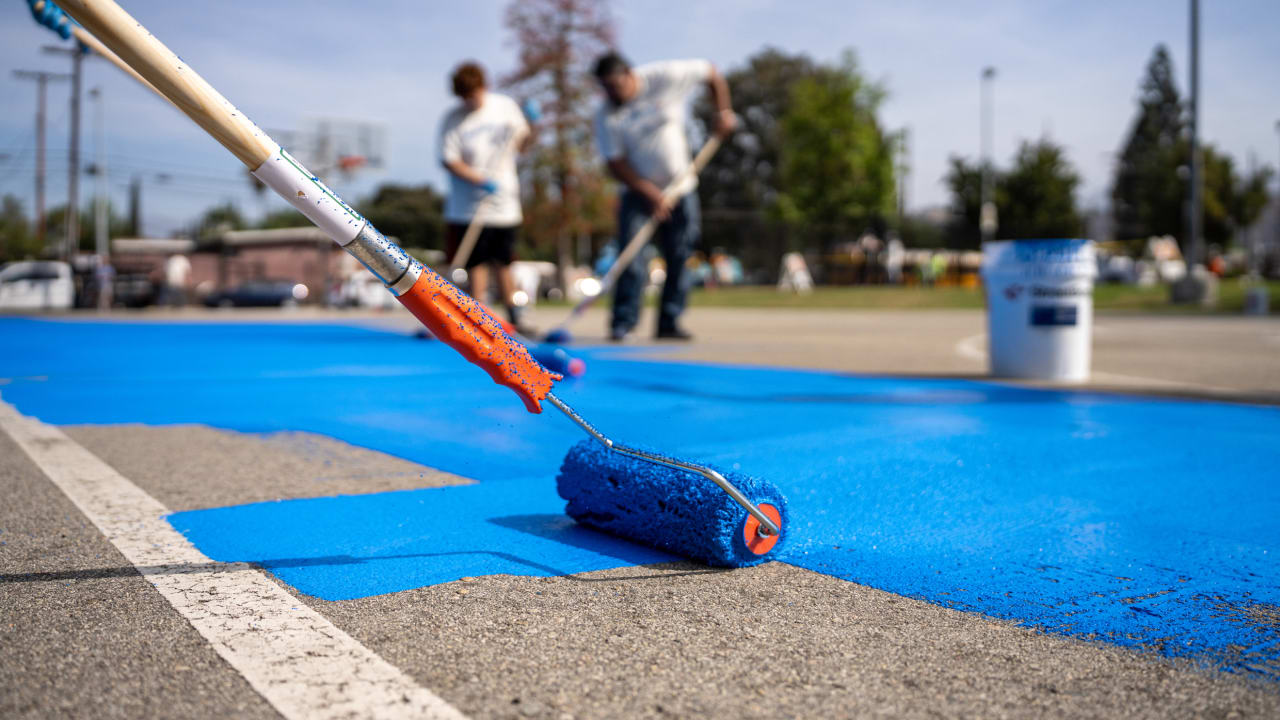
1 million square feet of L.A. roads are being covered with solar-reflective paint
The initiative covers roads, playgrounds, and parking lots, and it has already cooled the surface by 10 to 12 degrees.
- 08-17-22
1 million square feet of L.A. roads are being covered with solar-reflective paint
The initiative covers roads, playgrounds, and parking lots, and it has already cooled the surface by 10 to 12 degrees.
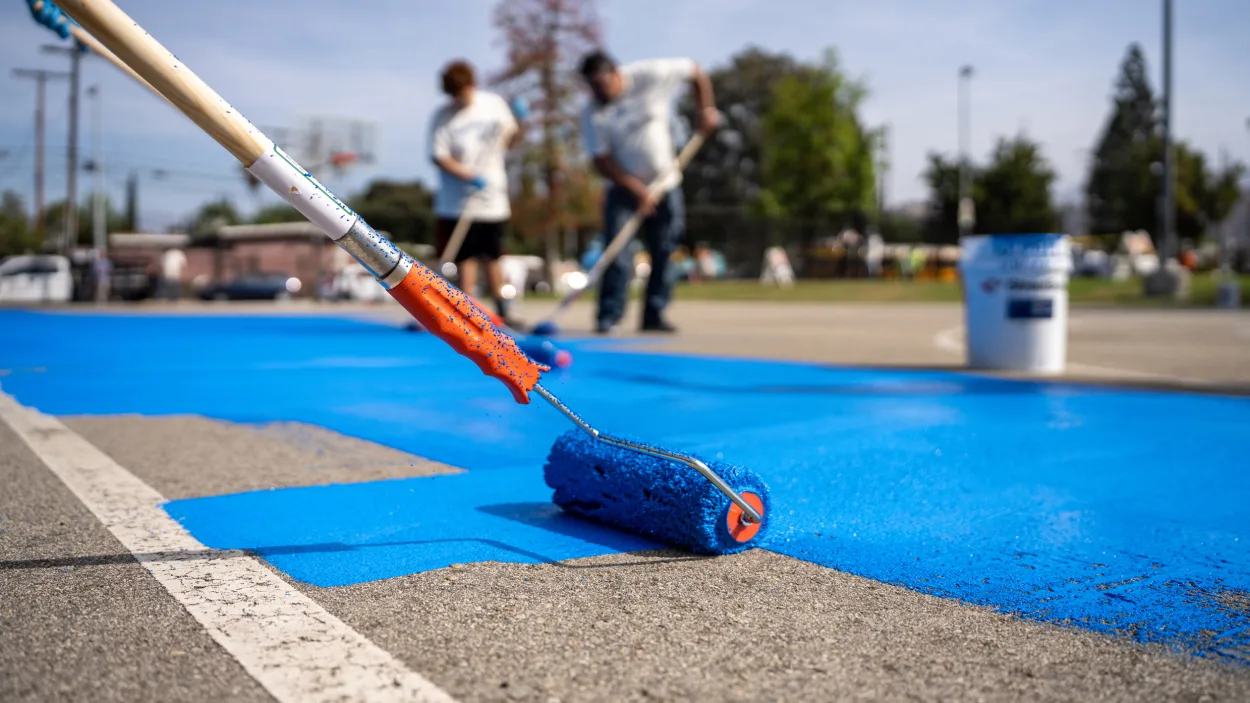
[Photo: courtesy GAF Cool Community Project]
BY ELISSAVETA M. BRANDON2 MINUTE READ
It’s no secret by now that cities run hotter than the countryside: Fewer trees mean less shade, and concentrated human activity generates heat, which hard surfaces like pavement and parking lots absorb.
To combat the so-called urban heat island effect, some cities have been retrofitting public buildings into climate shelters, while others have been planting thousands of trees. One Los Angeles neighborhood is turning to solar-reflective paint.
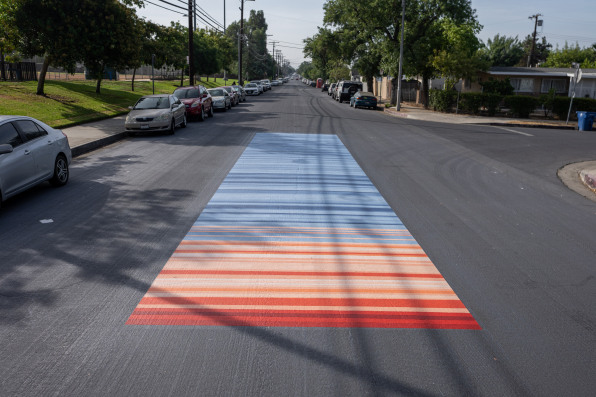
[Photo: courtesy GAF Cool Community Project]
The team behind the GAF Cool Community Project has just finished painting a whopping 1 million square feet of roads, playgrounds, and parking lots in Pacoima. The paint comes with special additives that reflect infrared light, meaning painted pavement ends up absorbing less heat.
Most of the surfaces have been painted a light shade of gray, but a local artist was commissioned to design a series of colorful murals on a basketball court, a school playground, and a parking lot.
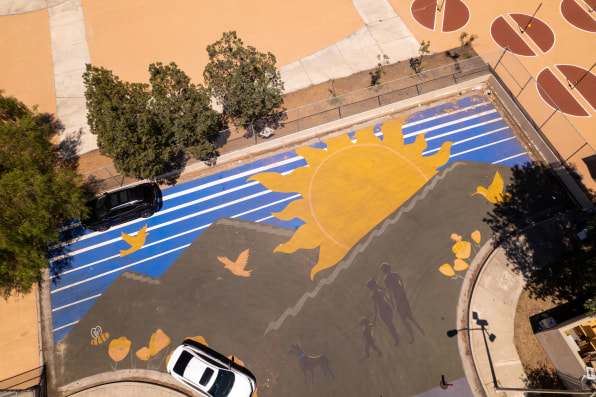
[Photo: courtesy GAF Cool Community Project]
The initiative comes on the heels of a series of dangerous heat waves in the U.S. affecting more than 16 million Americans. Painting streets may not be the silver bullet that fixes the urban heat island effect, but in Pacoima, it has already cooled the surface by about 10 to 12 degrees, highlighting the potential for a simple yet effective upgrade.
The project will now investigate how much the cooler surfaces will bring the neighborhood temperature down as a whole.
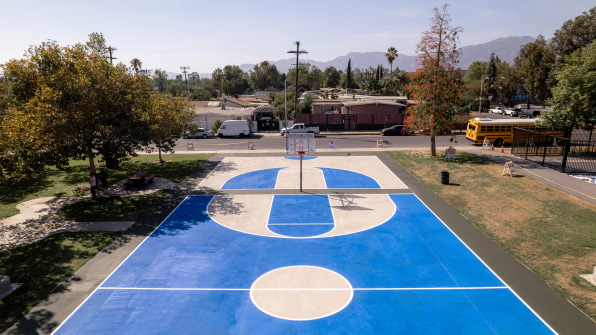
[Photo: courtesy GAF Cool Community Project]
It’s not the first time that cities have turned to paint to reduce heat (though typically, that paint is white, like in New York City, where more than 10 million square feet of rooftops have been painted in the past 10 years).
The Pacoima project was led by roofing giant GAF as a philanthropic initiative, which has already worked with the City of Los Angeles’s Cool Streets Project and the L.A. Unified School District to paint almost 90 playgrounds and school parking lots across the city.
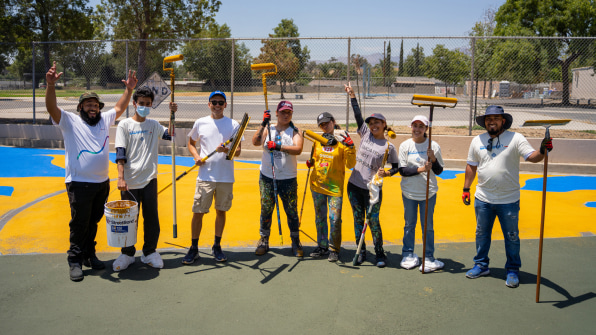
[Photo: courtesy GAF Cool Community Project]
The idea is to see if a larger-scale initiative can have even greater cooling effects. For now, the data is anecdotal: When they measured in the middle of the day, the team noticed a 30-degree difference compared to untreated pavement. But over the next two years, the company will gather weekly data on the surface temperature throughout the neighborhood—and if the initiative proves successful, they’re hoping to replicate the model across other neighborhoods.
“The ultimate goal is not just to lower the ambient temperature of the community but to see how it impacts the livelihoods of people in the community,” says Jeff Terry, vice president of corporate social responsibility and sustainability at GAF.
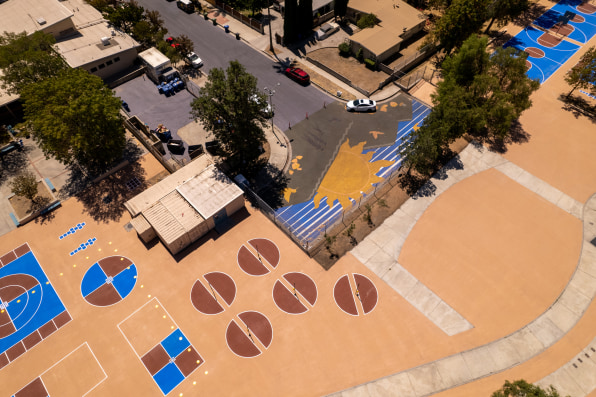
[Photo: courtesy GAF Cool Community Project]
The concept relies on a special kind of coating called Invisible Shade. (It’s produced by StreetBond, a GAF company.) Eliot Wall, StreetBond’s general manager, explains that Invisible Shade comes with additives that don’t just reflect visible light (like conventional white paint) but also infrared light (IR). (Sunlight consists of both types, but IR light accounts for most of the heat.)
“There’s a chance for a multiplier effect given those additives,” Wall says.
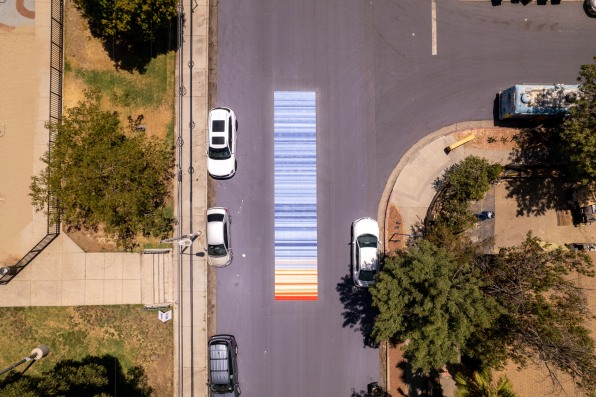
[Photo: courtesy GAF Cool Community Project]
The Invisible Shade collection comes in 14 colors, but custom colors are also possible, like the range of shades developed for a “warming stripes” mural depicting the annual temperature change in L.A. County from 1895 to 2021.
“We created a visual connection,” Wall says. “And in doing so, created a space where people can spend more time.”
